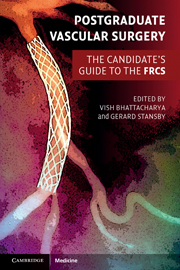Book contents
- Frontmatter
- Contents
- List of contributors
- Preface
- Section 1 Final FRCS vascular clinicals
- Section 2 Final FRCS vascular topics
- 1 Vascular risk factors and their management
- 2 Management of acute limb ischaemia
- 3 Chronic lower limb ischaemia, critical ischaemia and the diabetic foot
- 4 Endovascular and surgical options for peripheral revascularisation
- 5 Abdominal aortic aneurysms
- 6 Thoracic, thoracoabdominal and suprarenal aortic aneurysms
- 7 Aortic dissection
- 8 Popliteal artery aneurysms
- 9 Femoral artery aneurysms
- 10 Carotid, subclavian and vertebral disease
- 11 Diagnosis and management of thoracic outlet syndrome
- 12 Diagnosis and management of hyperhidrosis
- 13 Chronic mesenteric ischaemia
- 14 Acute ischaemic colitis
- 15 Vascular trauma
- 16 Indications and management of lower limb amputation
- 17 Leg swelling and lymphoedema
- 18 Varicose veins and chronic venous insufficiency
- 19 Management of deep vein thrombosis
- 20 Infection in vascular surgery
- 21 Vascular malformations
- 22 Vasospastic disorders and vasculitis
- 23 Critical care considerations and preoperative assessment for general and vascular surgery
- 24 Access surgery
- 25 Basic outline of solid organ transplantation
- Index
- References
20 - Infection in vascular surgery
- Frontmatter
- Contents
- List of contributors
- Preface
- Section 1 Final FRCS vascular clinicals
- Section 2 Final FRCS vascular topics
- 1 Vascular risk factors and their management
- 2 Management of acute limb ischaemia
- 3 Chronic lower limb ischaemia, critical ischaemia and the diabetic foot
- 4 Endovascular and surgical options for peripheral revascularisation
- 5 Abdominal aortic aneurysms
- 6 Thoracic, thoracoabdominal and suprarenal aortic aneurysms
- 7 Aortic dissection
- 8 Popliteal artery aneurysms
- 9 Femoral artery aneurysms
- 10 Carotid, subclavian and vertebral disease
- 11 Diagnosis and management of thoracic outlet syndrome
- 12 Diagnosis and management of hyperhidrosis
- 13 Chronic mesenteric ischaemia
- 14 Acute ischaemic colitis
- 15 Vascular trauma
- 16 Indications and management of lower limb amputation
- 17 Leg swelling and lymphoedema
- 18 Varicose veins and chronic venous insufficiency
- 19 Management of deep vein thrombosis
- 20 Infection in vascular surgery
- 21 Vascular malformations
- 22 Vasospastic disorders and vasculitis
- 23 Critical care considerations and preoperative assessment for general and vascular surgery
- 24 Access surgery
- 25 Basic outline of solid organ transplantation
- Index
- References
Summary
Key points
Infection of prosthetic vascular grafts is associated with a high mortality and morbidity
Prosthetic grafts should be avoided if the risk of infection is high
Early diagnosis requires a low index of suspicion
The greatest chance of long-term success lies in complete removal of the infected prosthesis and revascularisation with autologous material
A groin abscess in an intravenous drug abuser should be considered to be an infected false aneurysm of the femoral artery until positively excluded
Introduction
Managing the infective complications of arterial surgery represents one of the most complex challenges facing the vascular surgeon. Medical management alone seldom produces a satisfactory outcome but the removal of an infected prosthesis in a debilitated patient, possibly in the face of life-threatening haemorrhage, is rarely straightforward. The problem of then restoring distal perfusion may require innovative approaches whilst minimising the risk to the patient's life and reducing the likelihood of recurrent infection.
Epidemiology
Conventional surgical teaching is that ‘clean’ operative procedures should carry a postoperative wound infection rate of less than 1% (Table 20.1). Data from the Health Protection Agency (HPA) surveillance of surgical site infection rates however suggests that this is rarely achieved and approaches the sort of rates generally seen with clean-contaminated or contaminated procedures.
Causative organisms
Forty-six per cent of organisms seen in early postoperative infections following vascular procedures are staphylococcal, two-thirds of these being methicillin resistant Staphylococcus aureus (MRSA).
- Type
- Chapter
- Information
- Postgraduate Vascular SurgeryThe Candidate's Guide to the FRCS, pp. 229 - 241Publisher: Cambridge University PressPrint publication year: 2011



